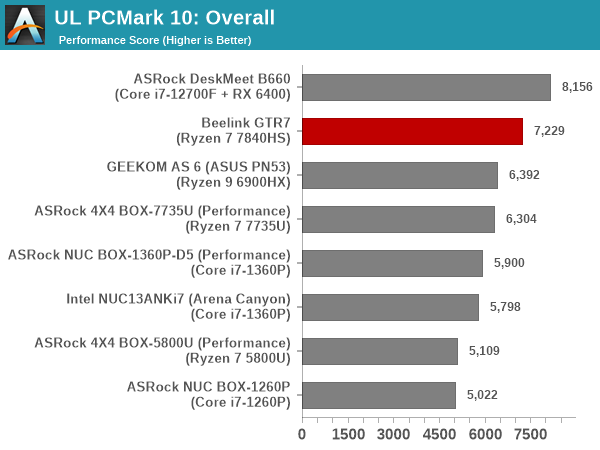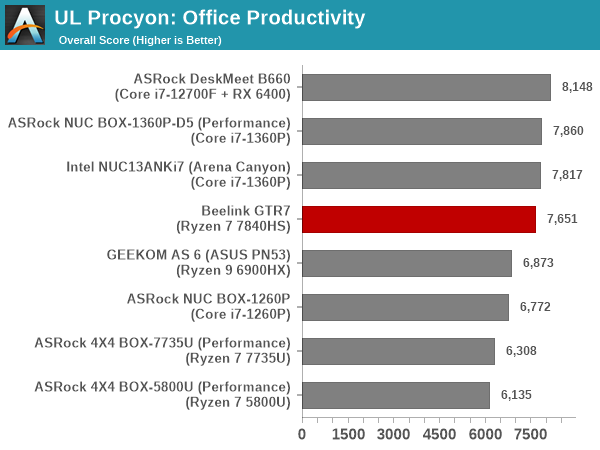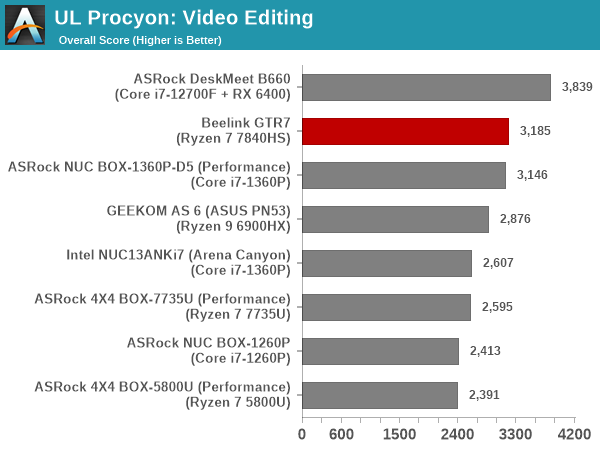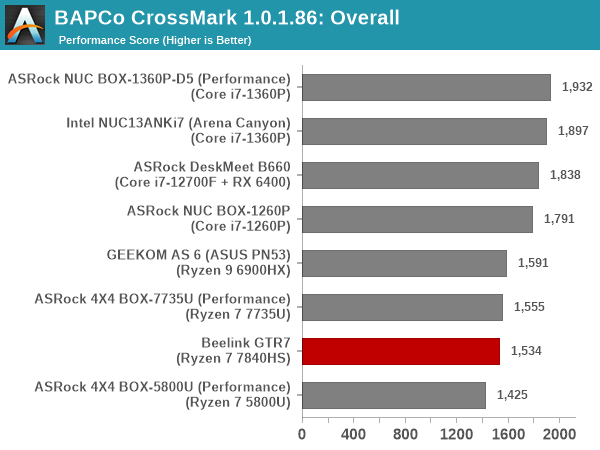Beelink GTR7 mini-PC Review: A Complete AMD Phoenix Package at 65W
by Ganesh T S on August 24, 2023 8:00 AM ESTSystem Performance: UL and BAPCo Benchmarks
Our 2022 Q4 update to the test suite for Windows 11-based systems carries over some of the standard benchmarks we have been using over the last several years. While UL's PCMark makes the list, we have opted to temporarily suspend reporting of BAPCo's SYSmark scores (pending fixture of the energy consumption aspect). Instead, BAPCO's CrossMark multi-platform benchmarking tool has been added to the set along with UL's Procyon suite. While CrossMark employs idle time compression and processes all workloads in an opaque manner, UL's Procyon processes real-world workloads with user interactions (like BAPCo's SYSmark). We have augmented the UL Procyon suite benchmark with our own custom energy measurement setup.
UL PCMark 10
UL's PCMark 10 evaluates computing systems for various usage scenarios (generic / essential tasks such as web browsing and starting up applications, productivity tasks such as editing spreadsheets and documents, gaming, and digital content creation). We benchmarked select PCs with the PCMark 10 Extended profile and recorded the scores for various scenarios. These scores are heavily influenced by the CPU and GPU in the system, though the RAM and storage device also play a part. The power plan was set to Balanced for all the PCs while processing the PCMark 10 benchmark. The scores for each contributing component / use-case environment are also graphed below.
| UL PCMark 10 - Performance Scores | |||

Discounting the DeskMeet B660, the GTR7 outscores the competition on the back of its lead in the productivity, gaming, and digital content creation workloads. The Essentials workload sees the Arena Canyon NUC enjoy a slight edge, but the sustained 65W configuration of the Ryzen 7 7840HS possesses way too much horsepower for the rest of the systems to match.
UL Procyon v2.1.544
PCMark 10 utilizes open-source software such as Libre Office and GIMP to evaluate system performance. However, many of their professional benchmark customers have been requesting evaluation with commonly-used commercial software such as Microsoft Office and Adobe applications. In order to serve their needs, UL introduced the Procyon benchmark in late 2020. There are five benchmark categories currently - Office Productivity, AI Inference, Battery Life, Photo Editing, and Video Editing. AI Inference benchmarks are available only for Android devices, while the battery life benchmark is applicable to Windows devices such as notebooks and tablets. We presents results from our processing of the other three benchmarks.
| UL Procyon - Office Productivity Scores | |||

The GTR7 manages a narrow victory in the Powerpoint workload, but the NUCs based on the Core i7-1360P emerge with slightly better overall scores.

From an energy consumption viewpoint, the 4nm fabrication process for the Ryzen 7840HS seems to help the GTR7. While raw performance scores see it slightly behind the Raptor Lake-based systems, the absolute values are fairly similar. However, the GTR7 gets the job done with minimal power consumption, and as a result, lesser overall energy consumption.
Moving on to the evaluation of Adobe Photoshop and Adobe Lightroom, we find the GTR7 coming out with a slightly better score compared to the systems using the Core i7-1360P. The flow utilizes some of the iGPU functionality, and the improvements in the Radeon 780M show up here along with the higher sustained power budget. Interestingly, the photo editing workload was the one that refused to complete with GPU drivers supplied initially by Beelink, but AMD's first public driver release for Phoenix resolved the issue.

The energy efficiency of the Phoenix SoC again comes to fore here, with the GTR7 being the most energy efficient by a huge margin.

UL Procyon evaluates performance for video editing using Adobe Premier Pro.

The GTR7 emerges as the best system among those not equipped with a discrete GPU. Its performance is within the realms of run-to-run variations with the souped up Core i7-1360P in ASRock Industrial's NUC BOX-1360P/D5.

On the energy front, the ability to get the job done fast helps in placing the GTR7 in the top half of the pack. The system comes second, falling slightly behind the ASRock Industrial NUC BOX-1360P/D5 with its CPU operating mode set to 'Performance' in the BIOS. However, similar to the raw performance scores, the gap is quite small.
BAPCo CrossMark 1.0.1.86
BAPCo's CrossMark aims to simplify benchmark processing while still delivering scores that roughly tally with SYSmark. The main advantage is the cross-platform nature of the tool - allowing it to be run on smartphones and tablets as well.
| BAPCo CrossMark 1.0.1.86 - Sub-Category Scores | |||

The use of idle time compression favors Intel-based systems, but that is not indicative of real-world performance. Based on these results, it would appear that scripting and automating workloads to keep the system busy all the time would probably be better on the Intel-based PCs. It is also possible that there could be BIOS tweaks and further tuning from Beelink to help the GTR7 perform better under such circumstances. Since CrossMark attempts to consolidate different workloads together without idle time intervals and play it back in a non-real-time environment, it is not entirely representative of real-world performance like PCMark 10 and UL Procyon. Therefore, tasks requiring frequent user interaction are better represented by those other benchmarks.










56 Comments
View All Comments
lemurbutton - Thursday, August 24, 2023 - link
You can get a M2 Mini for $499 on sale. It's superior to this in just about every way. Even if you upgrade the RAM for $200, it's still better than this. Faster CPU, faster GPU, has AI inference, faster RAM, significantly lower power requirements.meacupla - Thursday, August 24, 2023 - link
Well, yeah, obviously the $499 M2 mini is cheaper.It's a weaker PC than this, in every single metric.
It only has 8GB of RAM, 128GB SSD, both of which cannot be upgraded later on.
It's CPU and GPU are weaker than a 7840HS. To top it off M2 runs less efficiently and hotter.
Which is exactly why no one is buying it, and Apple had to halt M2 production.
ingwe - Thursday, August 24, 2023 - link
The mac mini has a 256GB SSD. Probably doesn't really need the ram upgrade. But...upgrading the SSD to 1 TB is $400. And not sure what you are saying about the M2 running less efficiently. Mac Mini is a fine option imo. But I would much rather have the GTR7 for a lot of reasons. Would be great for a streaming PC and console replacement for older games.PixyMisa - Thursday, August 24, 2023 - link
You can buy two 4TB SSDs for $400.Benjiro29 - Monday, November 6, 2023 - link
Hell, you can buy:* 8TB SSD for 320 Euro now. Or 2 * NVME for 320. Apple asks for 256GB "upgrade": 230 Euro
* 8GB DDR5 5600 Memory costs for 25 Euro. Apple asks for 8GB "upgrade: 230 Euro.
Insane ...that memory that Apple uses is just standard DDR5 memory, nothing special about it beyond being placed in quad channel configuration.
qwertymac93 - Thursday, August 24, 2023 - link
Does it run Windows 11 pro?bji - Thursday, August 24, 2023 - link
Why in the world would anyone *want to* though?TheinsanegamerN - Thursday, August 24, 2023 - link
Point taken, but so long as apple keeps doing its walled garden BS people will continue to rely on other OSes.ActionJ26 - Friday, August 25, 2023 - link
Why would anyone want to use iOS. My last company did and compared to Windows it is trash. Never thought I would say that. Some much of the functionality requires store bought add ones.darkswordsman17 - Friday, August 25, 2023 - link
Er, Mac Mini runs MacOS, not iOS.